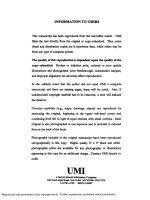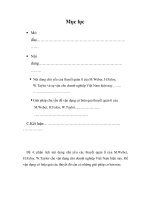sturge weber
Bạn đang xem bản rút gọn của tài liệu. Xem và tải ngay bản đầy đủ của tài liệu tại đây (1.9 MB, 26 trang )
CASE STUDY
Trần Thị Đỗ Quyên – NT44
CASE STUDY
-
BN nam, 37 tuổi
-
Tiền sử: khỏe mạnh
-
Lý do vào viện: đau nữa đầu phải, sưng đau mắt phải cách 1 tháng
-
Bớt bẩm sinh màu tím vùng trán và mắt bên phải
-
Khơng có dấu hiệu thần kinh khu trú
-
Đo nhãn áp: tăng nhãn áp mắt phải (22mmHg)
2
Annual Review
10/11/22
CASE STUDY
3
Annual Review
10/11/22
CT
4
Annual Review
10/11/22
CASE STUDY
5
Annual Review
10/11/22
CASE STUDY
6
Annual Review
10/11/22
CASE STUDY
BN nam 37 tuổi có bớt màu tím bẩm sinh ở trán và vùng mắt phải kèm đau nửa đầu và sưng đau mắt phải cách 1 tháng
Khám: tăng nhãn áp mắt phải
CT
-
Hình ảnh vơi hóa lan tỏa theo vùng vỏ và dưới vỏ bán cầu phải
-
Tăng kích thước đám rối mạch mạc não thất bên cùng bên
-
Tăng ngấm thuốc màng mạch mắt phải
Chẩn đoán: Sturge-Weber syndrome
7
Annual Review
10/11/22
STURGE-WEBER SYNDROME
Trần Thị Đỗ Quyên – NT 44
INTRODUCTION
A rare congenital neuro-dermatological disorder with angiomas that involve the leptomeninges, the skin of the face, eye.
Non-familial
1 in 50000
9
Annual Review
10/11/22
PATHOPHYSIOLOGY
10
Annual Review
10/11/22
PATHOPHYSIOLOGY
11
Annual Review
10/11/22
ROACH SCALE CLASSIFICATION
12
Type I – the most common
-
Facial and leptomeningeal angiomas; glaucoma
Type II:
-
Facial angioma alone, may have glaucoma
-
No CNS involvement
Type III :
-
Isolated leptomeningeal; usually no glaucoma
Annual Review
10/11/22
CLINICAL FEATURES
Port-wine stain
-
Congenital
-
Most often on the face, typically on the forehead, temple, or eyelid
Ophthalmic manifestation
-
Glaucoma buphthalmos, reduced vision
13
Annual Review
10/11/22
CLINICAL FEATURES
14
Neurologic symptoms: depending on the location of the LAs
-
Developmental delay
-
Seizures: 75-90%
-
Headache
-
Hemiparesis
-
Hemianopia
Annual Review
10/11/22
RADIOLOGIC FEATURES
15
The role of radiology
-
Diagnosis
-
Distinguishing
-
Follow-up
Plain skull x-rays: less usefull
CT: more sensitive to evaluate calcifications
MRI: abnormal myelination, leptomeningeal enhancement, orbital associated malformations
Annual Review
10/11/22
X- ray
16
Tram-track calcifications
Annual Review
10/11/22
17
A smaller hemicranium on the affected side.
Annual Review
10/11/22
CT Scannner
Tramline gyriform calcification
Cortical atrophy
Enlargement of choroid plexus
18
Annual Review
10/11/22
MRI: first choice
Direct signs
-
Leptomeningeal enhancement: the only direct sign for an early diagnosis, the cause can be related to a primary venous dysplasia and consequently an
hyperplasia of the leptomeningeal plexus
Indirect signs
-
White matter asymmetry (T1 hypersignal/T2 hyposignal)
-
Choroid plexus enlargement
-
Cortical atrophy
-
Tram-track sign of cortical and subcortical calcification
19
Annual Review
10/11/22
20
Annual Review
10/11/22
Diagnosis: 2/3 diagnostic criteria
Facial port-wine birthmark
Increased ocular pressure
Leptomeningial angiomatosis
/>21
Annual Review
10/11/22
Differential diagnosis
•
Gobbi syndrome:
-
The combination of celiac disease, epilepsy and bilateral occipital calcifications due to immune reaction
-
Childhood
-
Pathology: HLA-DQ2 and HLA-DQ8 genes
-
CT/MRI
+ Bilateral cortical and subcortical occipital calcification
+ Absence of lobar or hemispheric atrophy, leptomeningeal enhancement
22
Annual Review
10/11/22
Differential diagnosis
•
Leptomeningeal Enhancement
-
Meningitis
-
Leptomeningeal metastases
23
Annual Review
10/11/22
TREATMENT
Seizure: anticonvulsant drugs, hemispherectomy
Glaucoma: drugs to reduce IOP: beta- antigonist eye drops, carbonic anhydrase inhibitors, adrenergic eye drops and
miotic eye drops
24
PWS: laser therapy
Annual Review
10/11/22
CONCLUSION
Sturge-Weber syndrome: rare neurocutaneous disorder (angiomatosis of the skin, eye, and meninges)
Clinical features: facial port wine stains, neurologic symptom and ophthalmic symptoms
Imaging modalities: CT and MRI
Diagnosis: 2/3 diagnostic criteria (facial port-wine birthmark; increased ocular pressure; leptomeningial angiomatosis)
Treatment: Symptomatic treatment
25
Annual Review
10/11/22









